Abraliopsis
Richard E. Young and Kotaro Tsuchiya- Abraliopsis affinis
- Abraliopsis atlantica
- Abraliopsis chuni
- Abraliopsis falco
- Abraliopsis felis
- Abraliopsis gilchristi
- Abraliopsis hoylei
- Abraliopsis lineata
- Abraliopsis pacificus
- Abraliopsis morisii
- Abraliopsis tui
Introduction
Species of Abraliopsis are small squids that are most easily recognized by spherical "black" photophores (usually three) at the tip of each Arm IV. The black appearance is due to black chromatophores that typically cover the photophores but when the latter luminesce, the chromatophores withdraw from the photophores. This feature is shared with Watasenia scintillans from waters around Japan.
Brief diagnosis:
An enoploteuthid ...
- with large, black photophores at the tips of arms IV.
- with hooks of manus in two series.
Characteristics
The following characters are from Young, et al., 1998.
- Arms
- Suckers absent from arms IV (only hooks present).
- Suckers absent from arms IV (only hooks present).
- Tentacles
- Manus of club with two series of hooks and one series of suckers.
- Manus of club with two series of hooks and one series of suckers.
- Buccal crown
- Buccal crown with dark epithelial pigmentation on oral surface rather than typical chromatophores.*
- Fins
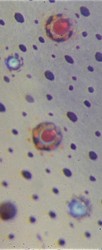
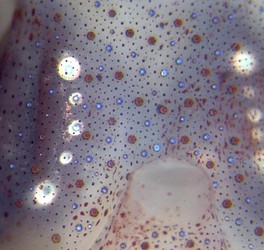
Figure. Ventral surface of the head and photophores of Abraliopsis pacificus. The photo on the left is an enlargement of some of the photophores.
- Fins extend to posterior end of tail.
- Fins extend to posterior end of tail.
- Photophores
- Two to four large photophores covered by black chromatophores on tips of each arm IV (see photograph under "Buccal crown.")*
- Five photophores on eyeball.*
- Complex organs of integument, in life, with red-colored filters.*
As in most other genera of the family, Abraliopsis has three types of integumental photophores covering the arms, head, funnel and mantle. The right-hand photo above shows the ventral surface of the head and funnel. The most complex of the integumental photophores have red color filters. The other two types appear as blue photophores with white cores in the photos and can be separated only by size in these pictures. Large white ocular photophores are also easily seen through the skin.
*Characters shared with Watasenia
References
Young, R. E., L. A. Burgess, C. F. E. Roper, M. J. Sweeney and S. J. Stephen. 1998. Classification of the Enoploteuthidae, Pyroteuthidae and Ancistrocheiridae. Smithson. Contr. Zool., No. 586: 239-256.
Title Illustrations

| Scientific Name | Abraliopsis pacificus |
|---|---|
| Location | off Hawaii |
| Image Use |
 This media file is licensed under the Creative Commons Attribution-NonCommercial License - Version 3.0. This media file is licensed under the Creative Commons Attribution-NonCommercial License - Version 3.0.
|
| Copyright |
© 2000 Richard E. Young

|
About This Page
Richard E. Young

University of Hawaii, Honolulu, HI, USA

Tokyo University of Fisheries, Tokyo, Japan
Page copyright © 2000 Richard E. Young and
 Page: Tree of Life
Abraliopsis .
Authored by
Richard E. Young and Kotaro Tsuchiya.
The TEXT of this page is licensed under the
Creative Commons Attribution-NonCommercial License - Version 3.0. Note that images and other media
featured on this page are each governed by their own license, and they may or may not be available
for reuse. Click on an image or a media link to access the media data window, which provides the
relevant licensing information. For the general terms and conditions of ToL material reuse and
redistribution, please see the Tree of Life Copyright
Policies.
Page: Tree of Life
Abraliopsis .
Authored by
Richard E. Young and Kotaro Tsuchiya.
The TEXT of this page is licensed under the
Creative Commons Attribution-NonCommercial License - Version 3.0. Note that images and other media
featured on this page are each governed by their own license, and they may or may not be available
for reuse. Click on an image or a media link to access the media data window, which provides the
relevant licensing information. For the general terms and conditions of ToL material reuse and
redistribution, please see the Tree of Life Copyright
Policies.
- Content changed 23 April 2008
Citing this page:
Young, Richard E. and Kotaro Tsuchiya. 2008. Abraliopsis . Version 16 October 2008 (under construction). http://tolweb.org/Abraliopsis/19644/2008.10.16 in The Tree of Life Web Project, http://tolweb.org/




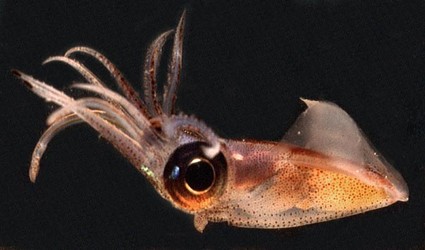
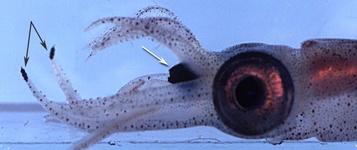
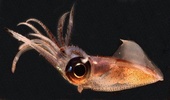


 Go to quick links
Go to quick search
Go to navigation for this section of the ToL site
Go to detailed links for the ToL site
Go to quick links
Go to quick search
Go to navigation for this section of the ToL site
Go to detailed links for the ToL site